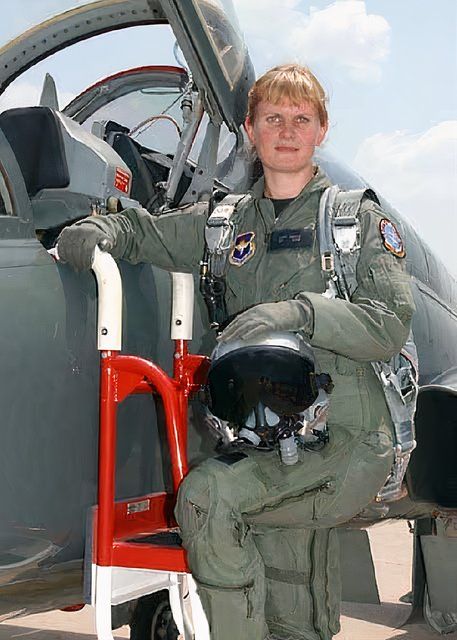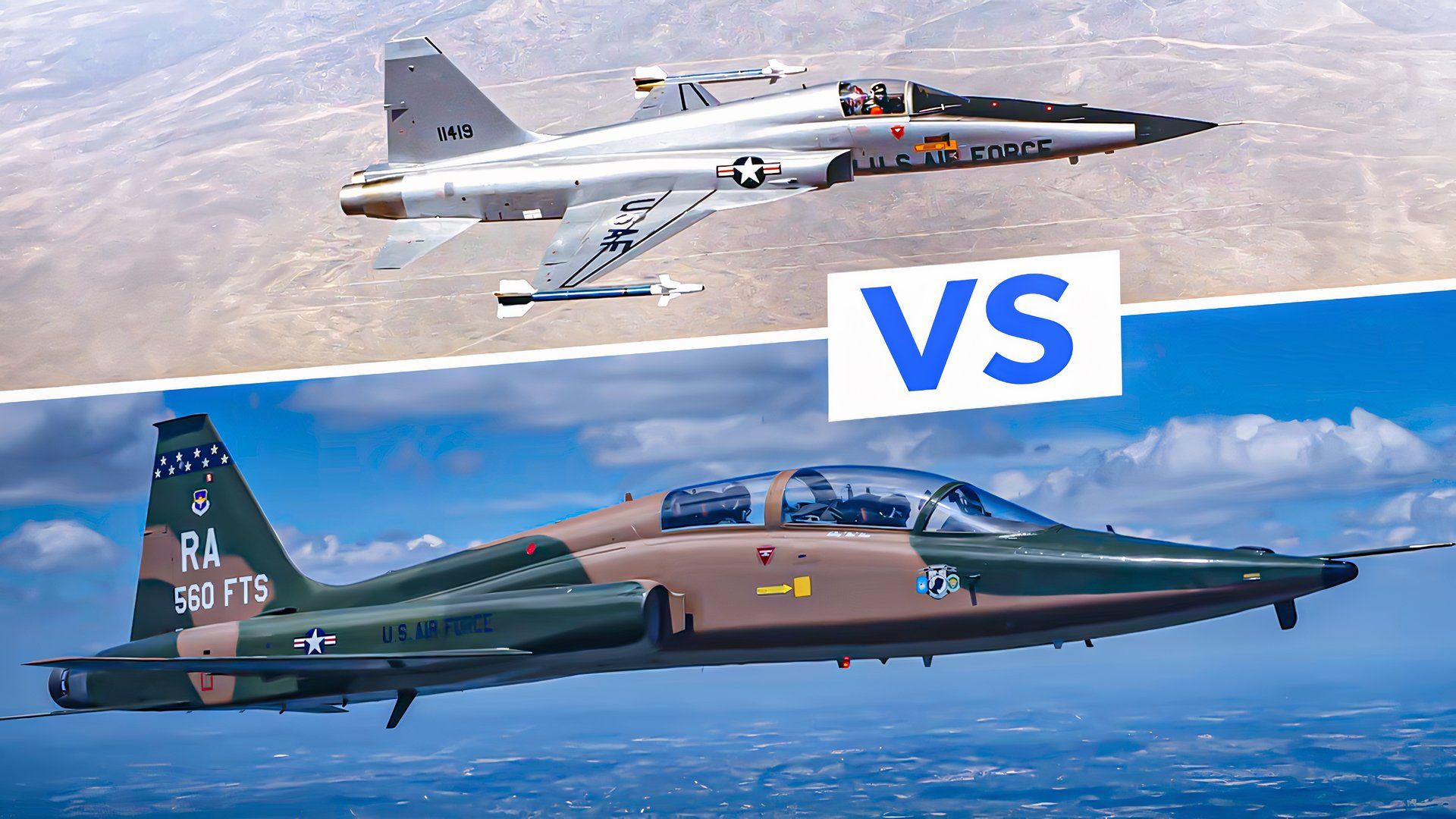The T-38 has been used by the Air Force Air Education and Training Command, serving as a trainer for front-line fighter and bomber pilots. NASA
used the trainer as a chasing and testing platform. It is known for its simplicity and reliability, making it an ideal learning platform for new pilots.
On the other hand, the F-5 is a fighter aircraft famous for its agility and speed. Its primary role is air superiority with the capability of a ground-attack platform. It was sold widely in many countries around the world. Northrop Grumman
Corporation manufactured both the F-5 and T-38.
The Talon: a legendary trainer
The Northrop Grumman Corporation T-38 Talon flew in 1959 and was delivered to the Air Force in 1961. It was developed to replace Lockheed T-33 trainers. The Pacer Classic program, which includes major structural replacements, extends the service life of T-38s to 2020. The T-38C is used for aerobatics, formation, night, instrument, and cross-country navigation training.
The Talon’s is the world’s first supersonic trainer. The single units, made of aluminum alloys, have been designed with internal honeycomb control surfaces. Over 72,000 US Air Force pilots have trained in it. The wings are designed to deliver on time, at or below contract price, and deliver performance as promised. Its life in service was extended until 2020.
The T-38 Talon is a twin-engine, high-altitude jet trainer used for various roles due to its design, economy of operations, ease of maintenance, high performance, and exceptional safety record. The T-38 has swept wings, a streamlined fuselage, tricycle landing gear, and two independent hydraulic systems.
The Talon has a glass cockpit with integrated avionics displays, a head-up display, and an electronic scoring system. T-38s modified by the propulsion modernization program have approximately 19% more thrust, reducing takeoff distance by 9 %. The instructor and student sit in tandem on rocket-powered ejection seats in a pressurized cockpit.
 Unboxing the Tiger’s features
Unboxing the Tiger’s features
The F-5 Freedom Fighter is a reliable supersonic fighter with a supportive aerodynamic design, low operating costs, and high performance.
Over 2,600 were built by Northrop Grumman under co-production agreements with countries like Canada, China, Korea, Spain, and Switzerland. From 1964 to 1989, every aircraft was delivered on time and with promised performance.
The F-5E Tiger II is a versatile and superior aircraft designed for air-to-ground and air-to-air operations. It has a 30% gross weight and a delta shape, with enlarged leading edge extensions for enhanced wing area and maneuverability. Northrop completed the ASIP aircraft structural integrity program in 1975 to ensure its structural design could perform in hostile environments.
The aircraft features a single-seat cockpit with electronic systems like automatic flight control systems and a head-up display. It has two 20mm Pontiac M39A2 cannons and seven hard points for mounting missiles and rockets. The aircraft is also equipped with unguided iron bombs, CBU-24/49/52/58 cluster bomb munitions, napalm bomb canisters, and M129 leaflet bombs.
Approximately two-thirds of the original production F-5s remain operational in 26 countries. US Northrop Grumman’s expertise in F-5 weapons systems integration and logistics supports the fleet for its projected life and ensures structural integrity.
The differences and similarities between the T-38 and the F-5
They are both fighter versions of the Northrop N-156 family, which initially had three proposed versions. Northrop designed it so that the Navy could use escort carriers for operations. The Navy N-156 has yet to go anywhere since the service opted to withdraw its escort carriers. The N-156T and N-156F were the two previous iterations.
“We pioneer with fierce curiosity, dedication, and innovation, we seek to solve the world’s most challenging problems.” Northrop Grumman Corp
Because of its much larger maximum takeoff weight, the F-5 can carry more weaponry and fuel, resulting in a more extended range and higher payload capacity. The F-5’s excellent thrust-to-weight ratio also allows it to ascend at higher rates and reach higher speeds, improving its agility and maneuverability in combat.
|
Performance Feature |
Northrop Grumman T 38 |
Northrop Grumman F 5 |
|---|---|---|
|
Power Plant |
Two General Electric J85-GE-5 |
Two General Electric J85-GE-21 |
|
Maximum Takeoff Weight |
12,093 pounds (5,485 kg) |
24,675 lb (11,192 kg) |
|
Speed |
812 mph (Mach 1.08, 1307 km/h) |
1,082 mph (Mach 1.63, 1,741 km/h) |
|
Range |
1,093 mi (1759 km) |
554 mi (891 km) |
|
Date Deployed |
March 1961 |
July 1963 |
Northrop Grumman developed the F-5 and T-38 as low-cost, lightweight aircraft for close air support and supersonic pilot training. Both share similar fuselage and wing features, but the T-38 is a two-seat variant. Upgrades and modifications have extended their service life, improving engines, avionics, and weapons systems and adding glass cockpits with heads-up displays.
|
Design Feature |
The T-38 Talon |
The F-5 Tiger |
|---|---|---|
|
Height |
12 feet, 10 inches (3.8 meters) |
13 ft 4.5 in (4.077 m) |
|
Wingspan |
25 feet, 3 inches (7.6 meters) |
26 ft 8 in (8.13 m) |
|
Length |
46 feet, 4 inches (14.1 m) |
48 ft 2.25 in (14.7 m) |
|
Empty weight |
7,200 lb (3,266 kg) |
9,583 lb (4,347 kg) |
|
Crew |
2 |
1 |
The worldwide ownership of the two aircraft
The F-5 and T-38 have been widely owned by air forces worldwide due to their performance. The Talon was well known for its dependability, adaptability, and low running costs. The F-5 has been successful for smaller air forces seeking an affordable fighter. The following table shows some of their ownership worldwide.
|
Aircraft |
T 38 |
F 5 |
|---|---|---|
|
Australia |
32 |
75 |
|
Canada |
120 |
150 |
|
Germany |
200 |
210 |
|
Greece |
50 |
120 |
|
Indonesia |
20 |
50 |
|
Iran |
30 |
100 |
|
Israel |
15 |
250 |
|
Japan |
200 |
250 |
|
Pakistan |
30 |
150 |
|
Philippines |
10 |
20 |
|
South Korea |
100 |
200 |
|
Taiwan |
50 |
150 |
|
Thailand |
20 |
50 |
|
Turkey |
100 |
200 |
|
United Kingdom |
150 |
0 |
|
United States |
1,200 |
1,000 |
The two aircraft have a unique and recognizable appearance because of their shared heritage and design lineage. The F-5 fighter aircraft is primarily used for combat roles, air superiority, and ground attack missions. It has a single-seat configuration, with one pilot onboard, while the T-38 is a trainer aircraft designed for pilot training.
The Tiger is armed with cannons, missiles, and bombs for air-to-air and ground missions, while the Talon is designed for basic pilot training. The F-5 is a supersonic fighter capable of reaching high speeds, while the T-38 is more cost-effective for worldwide acquisitions.

